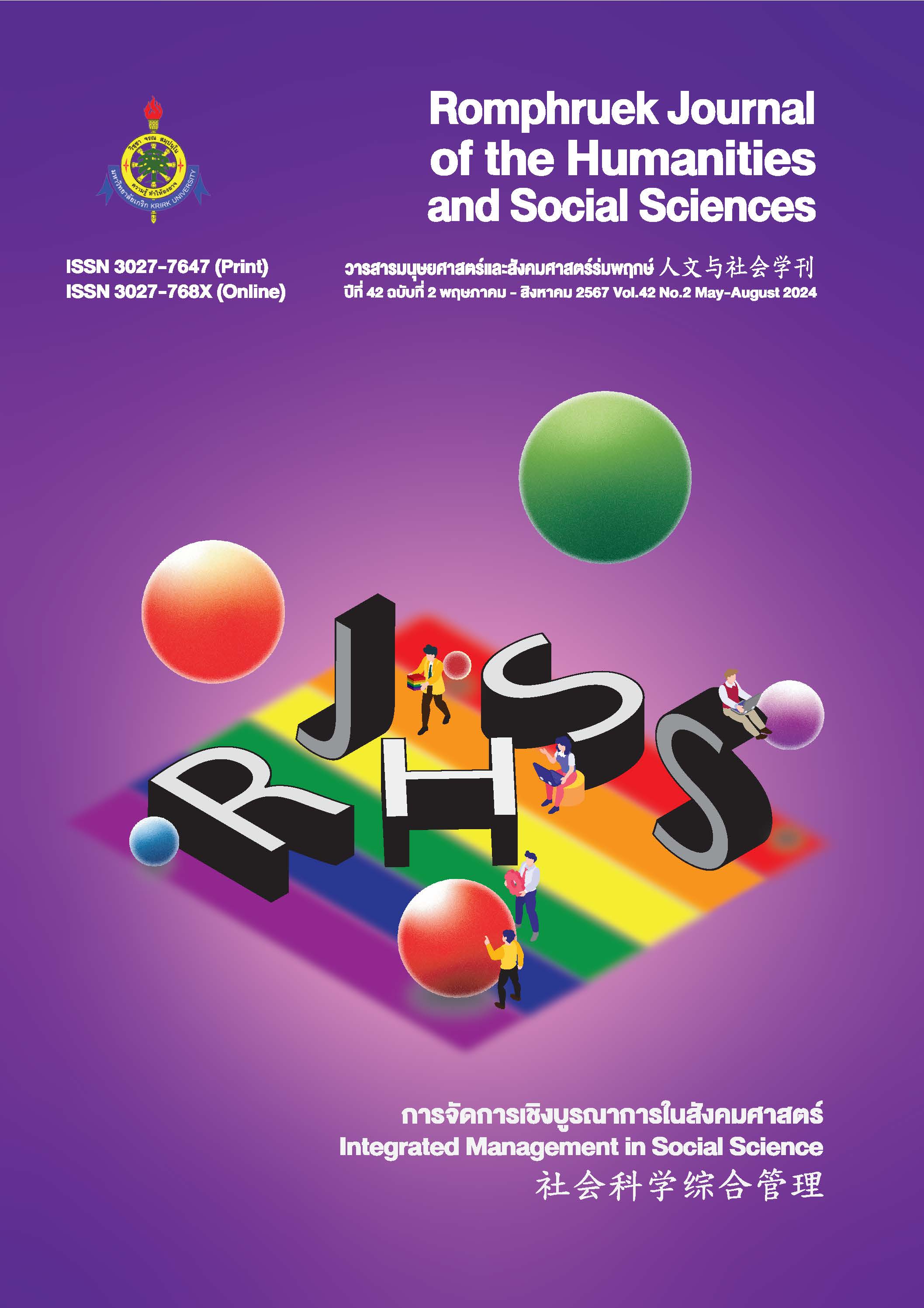The Effects of Using Learnin Package “Origami Transforming Paper” on Emotional Quotient of Early Childhood
Main Article Content
Abstract
The objectives of this research are to 1) create and assess the effectiveness of the learning package. “Origami Paper” on Emotional Intelligence of Early Childhood Children, 2) examine the emotional intelligence of early childhood children by contrasting the data obtained from the "Origami Paper" learning set before and after, and to 3) present guidelines for developing emotional intelligence of early childhood children. The target groups for this study were boys and girls aged between 5-6 years living in Watcharapol 3 Community, Soi Chatuchot 20, Or-Ngoen Subdistrict, Sai Mai District, Bangkok, who received informed consent from the parents of the target children of 45 people. The tools used in the research were: Learning set "Origami Paper" along with a manual for using the learning set, and Emotional Intelligence Assessment for Early Childhood Children to develop emotional intelligence of early childhood children. Quantitative data were analyzed by means of average, standard deviation, and the qualitative data were analyzed by content analysis.
The results of the research revealed that using “Origami paper” to develop the emotional intelligence of early childhood children produced an efficiency of 82.47/84.42, meeting the 80/80 efficiency criteria. After the experiment, the early childhood students who were instructed to use "Origami Paper" learning packages to enhance their emotional intelligence scored on average higher than they had previously. According to the expert opinions on 1) the development of emotional intelligence in early childhood children, the findings indicated that teachers should help children to identify their own emotions by letting them play with their friends, modelling kindness, sharing knowledge, being helpful to others, and accepting of their mistakes; 2) the development of emotional self-control, the result revealed that teachers should teach children to be patient and learn to wait; 3) Understanding others, teachers should instill in their students empathy for others, teach them to live happy, and motivate them to engage in physical activity. and 4) the development of human relationship, the teachers should encourage children to take part in school activities with other students, teachers, and people in the community.
Article Details

This work is licensed under a Creative Commons Attribution-NonCommercial-NoDerivatives 4.0 International License.
Every article published in the Romphruek Journal of the Humanities and Social Sciences is the opinion and point of view of the authors. Thery're not the viewpoint of Krirk University or the editored department. Any part or all of the articles for pablication must be clearly cited.
References
กรมสุขภาพจิต. (2566, 10 มกราคม). แนวทางการพัฒนาความฉลาดทางอารมณ์เด็กปฐมวัย. กองส่งเสริมและพัฒนาสุขภาพจิต. https://mhc4.dmh.go.th/wp-content/uploads/2023/02.pdf.
กองทุนเพื่อความเสมอภาคทางการศึกษา. (2564, 30 ธันวาคม). ชุดการเรียนรู้เคลื่อนที่ ‘นวัตกรรมแห่งปี’ ช่วยปิดช่องว่าง การศึกษายุคโควิด-19. กสศ. https://www.eef.or.th/article-innovation-of-the-year-311221/.
บัญชา ธนบุณสมบัติ. (2554). โอริงามิ เล่ม 1 พับกระดาษ...ฝึกสมอง. 3,000 เล่ม (พิมพ์ครั้งที่ 1). สำนักพิมพ์สารคดี.
ปิยะนันท์ หิรัณย์ชโลทร และกันตวรรณ มีสมสาร. (2558).การปลูกฝังและสร้างเสริมทักษะชีวิตสำหรับเด็กปฐมวัย.ในเอกสารการสอนชุดวิชาการพัฒนาทักษะชีวิตสำหรับเด็กปฐมวัย (หน่วยที่ 9, หน้า 9-1ถึง 9-46). นนทบุรี:
มหาวิทยาลัยสุโขทัยธรรมาธิราช.
มูลนิธิเพื่อเด็กพิการ. (2565, 1 มีนาคม). เด็กบกพร่องทางพฤติกรรมและอารมณ์ (Children with Behavioral and Emotional Disorders) . https://fcdthailand.org/library-type/.
วรรณพรรณ เลิศวัตรกานต์. (2557). การพัฒนาชุดกิจกรรมโดยเน้นงานปฎิบัติเพื่อฝึกทักษะการฟังและพูด ภาษาอังกฤษเพื่อการสื่อสารสำหรับนักเรียนชั้นประถมศึกษาปีที่ 5 โรงเรียนมารีวิทยา. (การค้นคว้าอิสระปริญญาศึกษาศาสตร์มหาบัณฑิต, มหาวิทยาลัยศิลปากร). SURE. https://sure.su.ac.th/xmlui/handle/123456789/7933?attempt=2&.
วารุณี มีหลาย. (2560, 3 มีนาคม). This entry was posted in การพยาบาลเด็ก. Bookmark the permalink. ความฉลาดทางอารมณ์กับเด็ก. http://164.115.41.60/.
สิริมา ภิญโญอนันตพงษ์. (2557). ดูแลลูกอย่างไรในวัยอนุบาล. บุ๊คบุรี.
สำนักงานคณะกรรมการส่งเสริมวิทยาศาสตร์ วิจัยและนวัตกรรม. (2563, 20 กรกฎาคม). พัฒนาการและพื้นฐานอารมณ์เด็กปฐมวัย – เพื่อการเติบใหญ่อย่างมีคุณภาพ. สืบค้นจาก.https://researchcafe.org/development- and-temperament-of-early-childhood/.
สำนักวิชาการและมาตรฐานการศึกษากระทรวงศึกษาธิการ. (2560, 9 มีนาคม). คู่มือหลักสูตรการศึกษาปฐมวัย พุทธศักราช 2560 สำหรับเด็กอายุ 3-6 ปี. http://110.78.114.133/chiangrai1/crdownload/data/P1CKnJBuq101838FriMar2018.pdf
อนุวัติ คูณแก้ว. (2559). การวิจัยเพื่อพัฒนาการเรียนรู้สู่ผลงานทางวิชาการเพื่อการเลื่อนวิทยฐานะ (พิมพ์ครั้งที่ 5). โรงพิมพ์แห่งจุฬาลงกรณ์มหาวิทยาลัย.
อัจฉราลักษณ์ ทั่งทอง. (2563). การให้ความรู้ผู้ปกครองเพื่อส่งเสริมความเป็นพลเมืองของเด็กปฐมวัย โดยใช้ชุดกิจกรรม “หนูน้อยสู้ภัยโควิด-19”. สิกขา วารสารศึกษาศาสตร์, 10(1), 167-181.
Goleman, D. (2014). Working with Emotional Intelligence. Bantam Book.
Selter , C,. (2002, 13 March). On the Arithmetical Flexinlity of Primary School Children Analyses
Based on the Example Task 701-698. ResearchGate. https://www.researchgate.net/publication/237772397_On_the_Arithmetical_Flexibility_of_Primary_School_Children_-_Analyses_Based_on_the_Example_Task_701-698.


